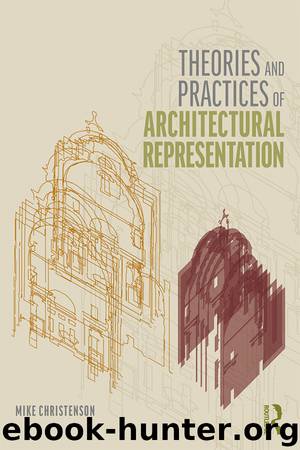Theories and Practices of Architectural Representation by Mike Christenson;

Author:Mike Christenson;
Language: eng
Format: epub
Publisher: Taylor & Francis (CAM)
Published: 2019-03-15T16:00:00+00:00
Territorial Devices
This doubled character, of making differences perceptible through both reading and writing, is typical of architectural interfaces generally. For example, a floor plan of an existing building, operating consistently with its function as a reading device, uniquely reveals the building’s contours and masses in a highly characteristic way; some things are excluded and remain invisible. Similarly, in its capacity as a writing device, the floor plan opens and enables a particular way of organizing thought; some dimensions of architecture are made more easily thinkable than others, and hence easier to put into action. The floor plan might be said to prompt ways of thinking about architecture that may be, for example, related to numerous possible paths of experience through space, the geometrical disposition of a structural system, or the continuity of enclosure separating interior from exterior. In a related way, coupled with their dual function as reading and writing devices, architectural interfaces operate both to enable and sustain conceptual negotiation; that is, they work like devices for organizing thought and through which concepts may be articulated and concretized.
This matters precisely because the theories and practices of architectural representation are abidingly and correctly concerned with architectural interfaces of all kinds—not just with buildings, but also with books, photographs, exhibitions, installations, and even urban infrastructure. The concern of architectural representation is not primarily with how these things and systems function to meet particular sets of stated design objectives so much as it is in how they operate as reading and writing devices. In this operation, architectural interfaces make specifically architectural thought and action possible and they provide conceptual structures for interactions between and among people, buildings, and cities. Considered as filters or media through which the world can be perceived and understood, not only skyways and freeways but even modes of transportation such as trains or cars could be considered architectural interfaces. Trains and cars, of course, are not themselves architecture, but nevertheless architects may be very interested in how travel by train or by car makes the world uniquely legible and accessible to change: in other words, in the capacity of a train, or of a car, to operate as an architectural interface. (A seminal architectural example occurs in the book Learning from Las Vegas, in which the authors discuss the possibility of buildings and signage being “inclined” towards car travel.19)
The challenge for architectural representation is to extract and highlight these interfaces as a way to examine and weigh their influence on perception, both independently and in combination with each other. What is interesting for architectural representation is the possibility of developing representational means to analyze these interactions: representational means uniquely responsive to conditions. As in Learning from Las Vegas, specific kinds of relationships (e.g., between drivers and buildings) can be represented and hence made actionable in characteristic ways. Venturi, Scott Brown, and Izenour made a point of creating new kinds of architectural representation for a new kind of environment even as they brought older tools, such as photography, into their arsenal.
Download
This site does not store any files on its server. We only index and link to content provided by other sites. Please contact the content providers to delete copyright contents if any and email us, we'll remove relevant links or contents immediately.
Kathy Andrews Collection by Kathy Andrews(11728)
The remains of the day by Kazuo Ishiguro(8819)
Paper Towns by Green John(5089)
Spare by Prince Harry The Duke of Sussex(5072)
Industrial Automation from Scratch: A hands-on guide to using sensors, actuators, PLCs, HMIs, and SCADA to automate industrial processes by Olushola Akande(4976)
The Body: A Guide for Occupants by Bill Bryson(4974)
Machine Learning at Scale with H2O by Gregory Keys | David Whiting(4176)
Be in a Treehouse by Pete Nelson(3943)
Never by Ken Follett(3788)
Harry Potter and the Goblet Of Fire by J.K. Rowling(3773)
Goodbye Paradise(3726)
Into Thin Air by Jon Krakauer(3308)
The Remains of the Day by Kazuo Ishiguro(3293)
The Cellar by Natasha Preston(3260)
The Genius of Japanese Carpentry by Azby Brown(3224)
Fairy Tale by Stephen King(3218)
120 Days of Sodom by Marquis de Sade(3179)
Drawing Shortcuts: Developing Quick Drawing Skills Using Today's Technology by Leggitt Jim(2996)
The Man Who Died Twice by Richard Osman(2995)
